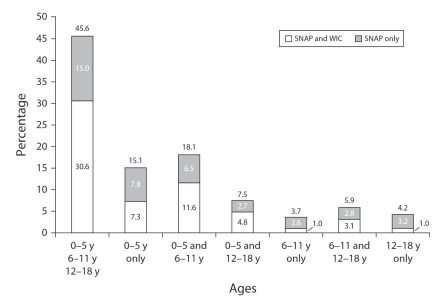Long-term impact of SNAP & WIC Participation on food security during childhood and adulthood

Food insecurity is a global issue. In the United States, 10,5% of families suffer from food insecurity in 2020 (13,7 million households). This prevalence is higher y among households with children and continue to rising (14.8% in 2020 vs. 13.6% in 2019). Numerous studies show that food insecurity is associated with negative health impacts (anxiety, depression, poorer quality of food, higher rates of diabetes and obesity, lower school performance) (Coleman-Jensen, 2019, Gundersen, 2014).
In the United States, the Supplemental Nutrition Assistance Program (SNAP) and the Special Supplemental Nutrition Program for Women, Infants, and Children (WIC) are the two largest federal programs. The aim of these programmes is to improve nutrition and food security for low-income people. In 2019, more than half of all children born in the USA and one in nine Americans received WIC benefits. There is strong evidence that these programs improve food security status, but less is known about the longer-term effect.
Therefore, the objective of this study is to quantify the impact of participation in SNAP and/or WIC programs during childhood on food security outcomes in adulthood among individuals who resided in low-income households during childhood.
A combination of WIC and SNAP programs for the majority of individuals followed
Nearly half of individuals were recipients of both WIC and SNAP. 32% of the panel received SNAP alone while only 5% received WIC alone.
Findings show that:
- 28% had an improved food security status from childhood to adulthood
- 24.4% of the sample reported high food security in childhood and adulthood
- 32.6% experienced a deterioration in food security status.

Individuals who experienced food insecurity as adults were much more likely to have received SNAP at some point during childhood. They were also significantly more likely to have lower incomes and to be less educated, single, and unemployed.
Children who received both SNAP and WIC benefits were 4.16 times more likely to improve their food security as adults
The predicted probabilities of becoming more food secure as an adult were 4 times higher in magnitude among those who received both SNAP and WIC and 3 times higher among those who received SNAP alone than among those who did not receive either during childhood.
Participation in both SNAP and WIC together had an overall positive effect on FSS greater than participation in either program in isolation. Participation in WIC alone did not improve food security. This could be explained by the fact that participation to WIC is limited to pregnant women and children under age 5. WIC benefits are not intended to provide food for entire families, but when participants are also enrolled in SNAP, the effects of the two programs can be synergistic.
Participation in social safety net programs such as SNAP and WIC during childhood helps to improve food security across the life course
The study highlights the need to continue to develop food aid programs for vulnerable households suffering from food insecurity as the results long-term effect in reducing food insecurity. However, even though these programs are useful, the subsidies do not allow a family to purchase enough healthy food for the entire month. This may change with the recent revisions to the Thrifty Food Plan, which increased benefits by an average of 27% over pre-pandemic levels.
Fruit and vegetable allowances in the WIC program also increased during the pandemic, which could also have a positive impact on food security and diet quality for participating children.
Yet, policies are needed to improve access to programs, minimize barriers to enrollment, and ensure adequacy of benefits so that today’s children suffering from food insecurity can benefit from these important programs now and in the future.
Based on : Insolera N, Cohen A, Wolfson JA. SNAP and WIC Participation During Childhood and Food Security in Adulthood, 1984-2019. Am J Public Health. 2022 Oct;112(10):1498-1506.
- Children who received both SNAP and WIC benefits were more likely to improve their food security as adults.
- Policies are needed to improve access to programs, minimize barriers to enrollment, and ensure adequacy of benefits so that today’s food insecure children can benefit from these important programs now and in the future.
